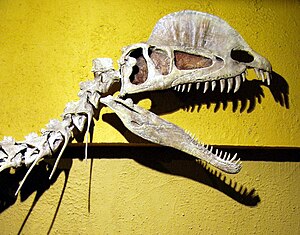Dilophosauridae: Difference between revisions
| [pending revision] | [pending revision] |
Studies are split, may as well include it with ? |
Chessboy123 (talk | contribs) mNo edit summary |
||
| Line 17: | Line 17: | ||
*''[[Dilophosaurus]]'' <small>([[Type (biology)|type]])</small> |
*''[[Dilophosaurus]]'' <small>([[Type (biology)|type]])</small> |
||
*''[[Dracovenator]]'' |
*''[[Dracovenator]]'' |
||
*''[[Zupaysaurus]]'' |
|||
}} |
}} |
||
'''Dilophosauridae''' is a [[Family (biology)|family]] of early carnivorous [[dinosaur]]s. They are well-known for their distinctive head crests, which were probably used for mating displays, or to intimidate rivals. The family was created by [[Alan J. Charig|Alan Charig]] and [[Andrew C. Milner|Andrew Milner]] in 1990 to contain only the [[Type (biology)|type genus]], ''[[Dilophosaurus]]''.<ref name="charig&milner1990">Charig, A.J. and Milner, A.C. (1990). "The systematic position of ''Baryonyx walkeri'', in the light of Gauthier's reclassification of the Theropoda." In Carpenter, K. and Currie, P.J. (eds.), ''Dinosaur Systematics: Perspectives and Approaches'', Cambridge University Press: 127-140.</ref> Other genera, such as ''[[Zupaysaurus]]'' and ''[[Dracovenator]]'', have since been assigned to this family, though the group has never been given a [[phylogenetic]] definition and is not currently a clade. Some studies have suggested that there was a natural group of medium-sized crested [[Theropoda|theropods]] which included ''Dilophosaurus'' as well as ''Dracovenator'', ''[[Cryolophosaurus]]'', and "Dilophosaurus" ''sinensis'', though it has not been formally named Dilophosauridae.<ref name="smithetal2007">Smith, N.D., Makovicky, P.J., Pol, D., Hammer, W.R., and Currie, P.J. (2007). "The dinosaurs of the Early Jurassic Hanson Formation of the Central Transantarctic Mountains: Phylogenetic review and synthesis." In Cooper, A.K. and Raymond, C.R. ''et al.'' (eds.), ''Antarctica: A Keystone in a Changing World––Online Proceedings of the 10th ISAES'', USGS Open-File Report 2007-1047, Short Research Paper 003, 5 p.; doi:10.3133/of2007-1047.srp003.</ref> While traditionally assigned to the superfamily [[Coelophysoidea]], these analyses suggest that dilophosaurids may have been more closely related to the group [[Tetanurae]], comprising the more advanced [[carnosaur]]s and [[Coelurosauria|coelurosaurs]]. |
'''Dilophosauridae''' is a [[Family (biology)|family]] of early carnivorous [[dinosaur]]s. They are well-known for their distinctive head crests, which were probably used for mating displays, or to intimidate rivals. The family was created by [[Alan J. Charig|Alan Charig]] and [[Andrew C. Milner|Andrew Milner]] in 1990 to contain only the [[Type (biology)|type genus]], ''[[Dilophosaurus]]''.<ref name="charig&milner1990">Charig, A.J. and Milner, A.C. (1990). "The systematic position of ''Baryonyx walkeri'', in the light of Gauthier's reclassification of the Theropoda." In Carpenter, K. and Currie, P.J. (eds.), ''Dinosaur Systematics: Perspectives and Approaches'', Cambridge University Press: 127-140.</ref> Other genera, such as ''[[Zupaysaurus]]'' and ''[[Dracovenator]]'', have since been assigned to this family, though the group has never been given a [[phylogenetic]] definition and is not currently a clade. Some studies have suggested that there was a natural group of medium-sized crested [[Theropoda|theropods]] which included ''Dilophosaurus'' as well as ''Dracovenator'', ''[[Cryolophosaurus]]'', and "Dilophosaurus" ''sinensis'', though it has not been formally named Dilophosauridae.<ref name="smithetal2007">Smith, N.D., Makovicky, P.J., Pol, D., Hammer, W.R., and Currie, P.J. (2007). "The dinosaurs of the Early Jurassic Hanson Formation of the Central Transantarctic Mountains: Phylogenetic review and synthesis." In Cooper, A.K. and Raymond, C.R. ''et al.'' (eds.), ''Antarctica: A Keystone in a Changing World––Online Proceedings of the 10th ISAES'', USGS Open-File Report 2007-1047, Short Research Paper 003, 5 p.; doi:10.3133/of2007-1047.srp003.</ref> While traditionally assigned to the superfamily [[Coelophysoidea]], these analyses suggest that dilophosaurids may have been more closely related to the group [[Tetanurae]], comprising the more advanced [[carnosaur]]s and [[Coelurosauria|coelurosaurs]]. |
||
Revision as of 16:47, 25 January 2010
| Dilophosaurids Temporal range: Late Triassic-Middle Jurassic
| |
|---|---|

| |
| Dilophosaurus skull and neck, Royal Tyrrell Museum | |
| Scientific classification | |
| Kingdom: | |
| Phylum: | |
| Class: | |
| Order: | |
| Suborder: | |
| Family: | Dilophosauridae |
| Genera | |
Dilophosauridae is a family of early carnivorous dinosaurs. They are well-known for their distinctive head crests, which were probably used for mating displays, or to intimidate rivals. The family was created by Alan Charig and Andrew Milner in 1990 to contain only the type genus, Dilophosaurus.[1] Other genera, such as Zupaysaurus and Dracovenator, have since been assigned to this family, though the group has never been given a phylogenetic definition and is not currently a clade. Some studies have suggested that there was a natural group of medium-sized crested theropods which included Dilophosaurus as well as Dracovenator, Cryolophosaurus, and "Dilophosaurus" sinensis, though it has not been formally named Dilophosauridae.[2] While traditionally assigned to the superfamily Coelophysoidea, these analyses suggest that dilophosaurids may have been more closely related to the group Tetanurae, comprising the more advanced carnosaurs and coelurosaurs.
Phylogeny
The following cladogram outlines the relationships of Dilophosaurus and its close relatives as recovered by the 2007 analysis of Smith, Makovicky, Pol, Hammer, and Currie.[2]
| Theropoda |
| ||||||||||||||||||||||||||||||
References
- ^ Charig, A.J. and Milner, A.C. (1990). "The systematic position of Baryonyx walkeri, in the light of Gauthier's reclassification of the Theropoda." In Carpenter, K. and Currie, P.J. (eds.), Dinosaur Systematics: Perspectives and Approaches, Cambridge University Press: 127-140.
- ^ a b Smith, N.D., Makovicky, P.J., Pol, D., Hammer, W.R., and Currie, P.J. (2007). "The dinosaurs of the Early Jurassic Hanson Formation of the Central Transantarctic Mountains: Phylogenetic review and synthesis." In Cooper, A.K. and Raymond, C.R. et al. (eds.), Antarctica: A Keystone in a Changing World––Online Proceedings of the 10th ISAES, USGS Open-File Report 2007-1047, Short Research Paper 003, 5 p.; doi:10.3133/of2007-1047.srp003.